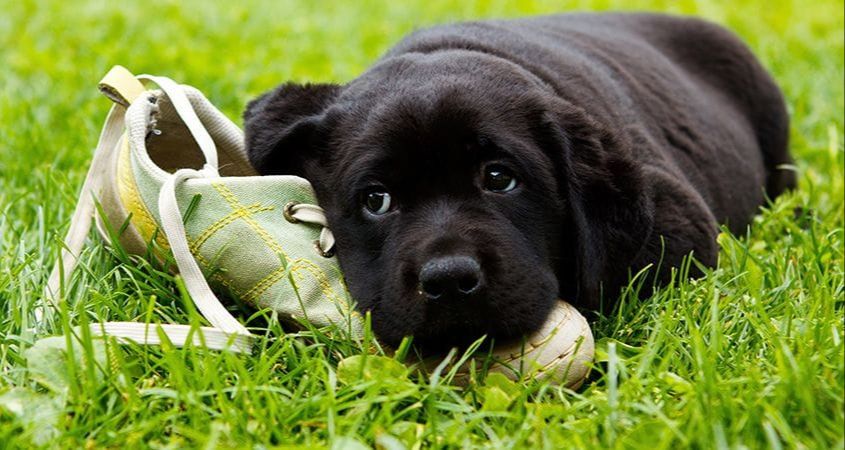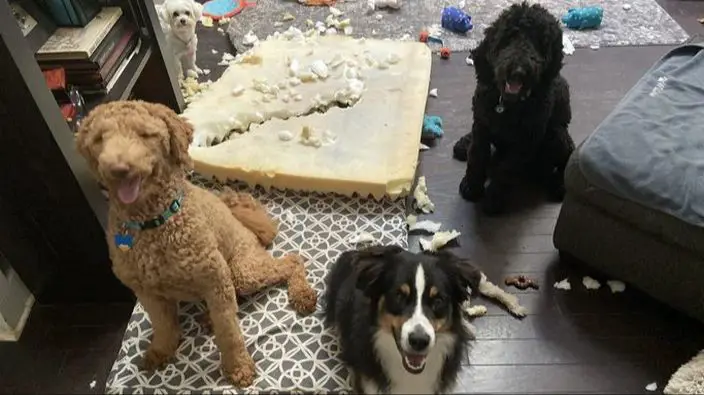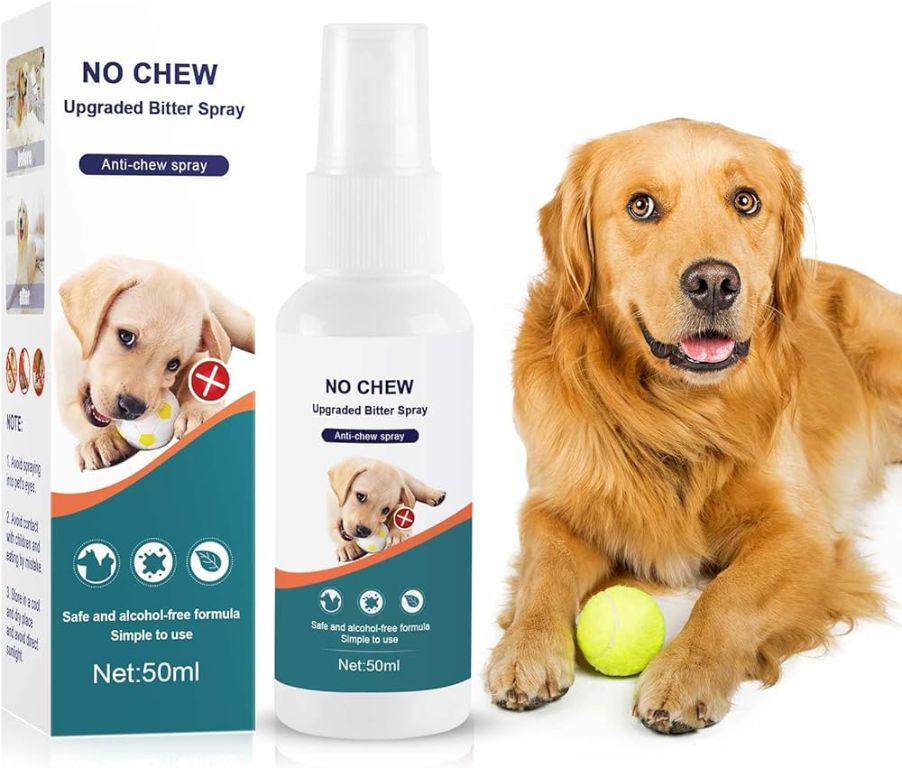Introduction
Aggressive chewing is a common behavioral issue seen in dogs, especially during puppyhood. It involves dogs that go beyond normal chewing and start destroying and ingesting household objects. Aggressive chewing stems from dogs exploring the world with their mouths, teething pain, boredom, anxiety, and other factors. While it’s normal for dogs to chew, aggressive chewing can become destructive and dangerous if left unchecked. Understanding why dogs chew aggressively and how to curb the behavior is important for any dog owner.
This article provides an in-depth look at aggressive chewing in dogs. It covers the breeds most prone to this behavior, underlying reasons for it, how to identify it, dangers involved, and most importantly – how to stop it through proper training, enrichment, and chew toys. We’ll also discuss when aggressive chewing may indicate an underlying medical or psychological problem requiring professional help. The goal is to provide dog owners the information needed to understand, manage, and hopefully resolve their dog’s destructive chewing habits.
Breeds Prone to Aggressive Chewing
Some dogs are naturally more prone to aggressive chewing behaviors due to their breed. Certain breeds like Labrador retrievers, pit bulls, and Jack Russell terriers tend to chew more than others.
Labrador retrievers are one of the most popular dog breeds, and they are also known for being big chewers. Their origins as hunting and working dogs mean they have a strong urge to chew. Labs will chew on furniture, shoes, toys, and anything else they can get their mouths on. Their powerful jaws can destroy objects quickly [1].

Pit bull breeds, including the American pit bull terrier, are also prone to destructive chewing, especially as puppies. Strong chewers by nature, pit bulls have muscular jaws capable of chewing through tough materials. They love to chew wood, furniture, drywall, and whatever else captures their interest [2].
The Jack Russell terrier is a small but mighty breed known for its energy and tendency to chew. Originally bred as hunting dogs, Jack Russells often chew items like shoes, furniture, and books. Without proper outlets for their energy, these terriers will chew destructively.
Reasons for Aggressive Chewing
There are several common reasons why dogs may engage in aggressive chewing behaviors:
Boredom – Dogs need mental and physical stimulation. Without adequate exercise and enrichment activities, dogs may turn to destructive chewing as an outlet for pent-up energy and boredom. Leaving dogs alone for long periods without access to appropriate chew toys is a common cause of aggressive chewing due to boredom.
Anxiety – Dogs suffering from separation anxiety or other types of anxiety may chew items aggressively when stressed. The act of chewing helps relieve anxiety and provides comfort. Aggressive chewing from anxiety often targets specific items that smell like the dog’s owner.

Teething – Puppies teethe similarly to human babies. Chewing helps relieve the pain and discomfort of their growing teeth pushing through the gums. Puppies typically teethe until around 6-7 months old. Aggressive chewing often peaks during the main teething phase between 3-6 months old.
References:
https://hubknot.com/pets/why-do-dogs-chew-aggressively/
https://newbridgereports.com/why-do-dogs-chew-aggressively-from-deceptiveness-to-openness/
How to Identify Aggressive Chewing
Destructive, excessive, and compulsive chewing behaviors are hallmarks of aggressive chewing in dogs. Here are some signs that your dog may be an aggressive chewer:
- Destroys toys and other objects quickly by aggressively biting, pulling, and shaking them
- Chews rapidly for long periods of time, even when toys are shredded or consumed
- Swallows pieces of toys, rocks, furniture, etc rather than just gnawing or nibbling
- Leaves deep tooth marks in objects, sometimes damaging or destroying them
- Focuses chewing on specific surfaces like furniture, windowsills, door frames, etc.
- Chewing seems obsessive and is difficult to interrupt or redirect
- May chew when excited, bored, stressed or anxious
The more of these signs you notice, the more likely your dog has a serious chewing compulsion. Aggressive chewers won’t stop after a few minutes of normal gnawing – they will destroy anything in their path. Understanding the severity of the issue is the first step to curbing excessive chewing.
(Source: https://www.petopiatoys.com/blog/blog-p1/)
Dangers of Aggressive Chewing
Aggressive chewing can pose serious dangers to a dog’s health. Two of the biggest risks are choking hazards and intestinal blockages.
Certain chews or items that are small enough to swallow can easily become lodged in a dog’s throat, blocking their airway. This can lead to choking, breathing difficulties, and even death if not quickly dislodged. Hard, dense chews are especially dangerous as they do not compress if swallowed. Some high-risk choking hazards for aggressive chewers include rawhide, hooves, bones, sticks, balls, rocks and ice cubes.

Intestinal blockage is another major concern. When items are swallowed whole instead of chewed properly, they can cause obstructions as they pass through the intestinal tract. Symptoms may include vomiting, diarrhea, loss of appetite and abdominal pain. Without treatment, blockages can be fatal. Aggressive chewers are at high risk if they gulp down items like socks, stones, children’s toys or chunks of plastic, rubber or wood.
It’s important to closely monitor aggressive chewers and remove unsafe items from their environment. Provide only appropriate chew toys that cannot easily be destroyed and swallowed. Supervise chewing time and contact your vet immediately if choking or blockage is suspected.
Stopping Aggressive Chewing
There are several effective techniques to curb and stop aggressive chewing in dogs.
First, ensure your dog gets plenty of exercise and physical activity. Dogs that don’t get enough exercise are more likely to chew destructively out of boredom and pent up energy. Aim for at least 30-60 minutes of brisk walking or playing with your dog per day.
Provide your dog with plenty of appropriate chew toys to satisfy their natural chewing instinct. Rotate the toys to keep them interesting. Offer long-lasting chews like Nylabones, Kongs filled with peanut butter, and rope toys.
Use crate training techniques when you can’t supervise your dog. Confine them to a crate with a chew toy when you’re away to prevent access to off-limit items. Gradually increase alone time as they learn not to chew inappropriately.
With diligence, patience, and by addressing the underlying causes, you can curb destructive chewing in dogs. Consult a vet or trainer if aggressive chewing persists despite these tactics.
Best Chew Toys for Aggressive Chewers
When choosing chew toys for aggressive chewers, it’s important to select durable options that can stand up to relentless gnawing. Some of the top recommendations include:
Kongs – Made of virtually indestructible rubber, Kongs are a go-to choice for heavy chewers. The rubber helps massage gums and clean teeth. Kongs can be stuffed with treats or peanut butter to occupy dogs for hours.
Nylabones – These long-lasting chew toys are made of nylon and come in different textures and flavors. The bristles and nubs help control plaque and tartar as dogs chew. Be sure to select a size and strength appropriate for your dog.
Antlers – Deer, elk, and moose antlers are very hard, which makes them ideal for aggressive chewers. Antlers can splinter over time, so owners should monitor condition. But their appeal to dogs is undeniable.
In general, the most durable chew toys will be made of hard rubber, nylon, or antlers. Avoid toys with stuffing, which can be easily destroyed and ingested. Supervision is still recommended with any chew toy to ensure dog safety.
Other Tips for Curbing Chewing
In addition to providing appropriate chew toys, there are some other techniques that can help curb excessive chewing behavior:
Bitter Spray Deterrents – Applying a bitter citrus or apple spray to furniture, baseboards, and other off-limit items can deter dogs from chewing on them. The bitter taste helps teach them that these items are not for chewing. Just be sure to reapply frequently, as the spray can wear off over time.

Supervision – Closely supervising your dog and redirecting their chewing to appropriate toys is key. If you catch them in the act of chewing something they shouldn’t, interrupt the behavior with a firm “No,” then redirect them to a sanctioned chew toy. Praise them when they redirect their chewing to the right object.
For more tips, see this guide from Nationwide Pet Insurance: http://bit.ly/1u74CpS
When to Seek Professional Help
If your dog’s chewing behavior seems abnormally excessive or destructive, it may be time to seek professional help from an animal behaviorist or veterinarian. Some signs that your dog’s chewing has become problematic and warrants outside intervention include:
- Chewing that leads to injury, such as bloody paws or mouth
- Chewing that results in destruction of property, like furniture, shoes, baseboards, etc.
- Incessant chewing on inappropriate items no matter how much redirection is attempted
- Chewing accompanied by other symptoms like anxiety, pacing, or aggression
- Chewing that intensifies when left alone, indicating separation anxiety
A professional animal behaviorist can observe your dog’s chewing habits and help uncover the underlying motivation behind the behavior. They may recommend changes to your dog’s routine, enrichment activities, anxiety mediation or training to curb the destructive chewing. In some cases, medication may be prescribed in conjunction with behavior modification. Your veterinarian can also check for underlying medical conditions like gastrointestinal issues, pain, food allergies or neurological disorders that could be causing your dog distress and leading to the excessive chewing behavior. Don’t hesitate to enlist the help of professionals if your dog’s chewing has become hazardous or destructive.
Conclusion
Aggressive chewing is a common issue among certain dog breeds prone to the behavior, especially while teething, anxious, bored, or lacking sufficient physical and mental exercise. Key takeaways include identifying breeds prone to excessive chewing, understanding reasons behind the behavior, looking for signs of destructive chewing, providing appropriate chew toys, and seeking training or medical advice if needed. While challenging to curb, using a combination of prevention, redirection, and patience can help stop aggressive chewing. If the behavior persists, consulting a veterinarian or certified dog trainer/behaviorist may provide additional solutions. Overall, aggressive chewing stems from natural canine instincts and traits that require proper management and training but can be overcome with consistency, care and meeting a dog’s needs.